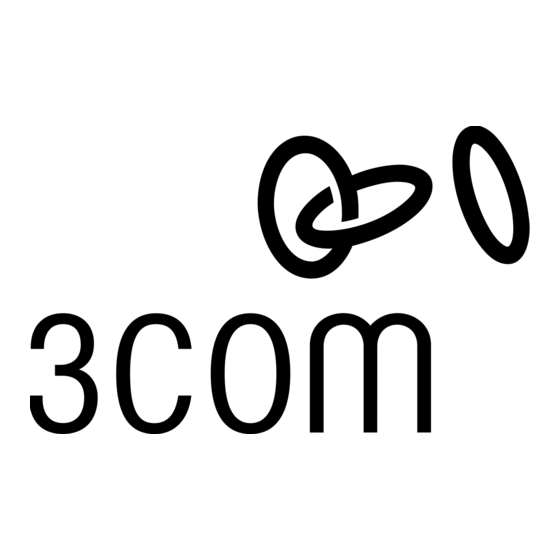3Com Baseline 3C16476 User Manual - Page 2
Browse online or download pdf User Manual for Switch 3Com Baseline 3C16476. 3Com Baseline 3C16476 8 pages. Superstack 3 baseline 10/100 switch 48-port 10base-t/100base-tx plus 2-port gigabit

H
U
OW TO
The numbers in this diagram refer to numbered sections in the text.
Front Panel
1
48 RJ-45 10/100 Ports and 2 RJ-45 10/100/1000 BASE-T Ports
WARNING: RJ-45 ports. These are shielded RJ-45 data
sockets. They cannot be used as standard traditional tele-
phone sockets, or to connect the unit to a traditional PBX or
public telephone network. Only connect RJ-45 data connec-
tors, network telephony systems, or network telephones to
these sockets. Either shielded or unshielded data cables with
shielded or unshielded jacks can be connected to these data
sockets
AVERTISSEMENT: Points d'accès RJ-45. Ceux-ci sont pro-
tégés par des prises de données. Ils ne peuvent pas être util-
isés comme prises de téléphone conventionnelles standard, ni
pour la connection de l'unité à un réseau téléphonique cen-
tral privé ou public. Raccorder seulement connecteurs de
données RJ-45, systèmes de réseaux de téléphonie ou télé-
phones de réseaux à ces prises. Il est possible de raccorder
des câbles protégés ou non protégés avec des jacks protégés
ou non protégés à ces prises de données.
VORSICHT: RJ-45-Porte. Diese Porte sind geschützte Dat-
ensteckdosen. Sie dürfen weder wie normale traditionelle
Telefonsteckdosen noch für die Verbindung der Einheit mit
einem traditionellem privatem oder öffentlichem Telefon-
netzwerk gebraucht werden. Nur RJ-45-Datenanscluße, Tele-
fonnetzsysteme or Netztelefone an diese Steckdosen
anschließen. Entweder geschützte oder ungeschützte Buch-
sen dürfen an diese Datensteckdosen angeschlossen werden.
10BASE-T/100BASE-TX Ports
The Switch has 48 auto-negotiating 10BASE-T/100BASE-TX ports con-
figured as Auto MDIX (cross-over). These ports automatically detect
whether they need to operate in MDI or MDIX mode. Each ports
speed and duplex mode (half duplex or full duplex) is automatically
determined by the capabilities of the connected device. The maximum
segment length is 100 m (328 ft) over Category 5 twisted pair cable.
CAUTION: The Baseline Switch supports full duplex
!
auto-negotiation. If the connected device does not support
auto-negotiation, the Switch will operate in half duplex
mode (even if the device is operating in full duplex mode). In
such a configuration, you may notice some degradation of
network performance. 3Com recommends that you use
devices that are capable of auto-negotiation (and that you
ensure that auto-negotiation is enabled, if it is a configurable
option).
10/100/1000BASE-T Ports
The Switch has two auto-negotiating 10/100/1000BASE-T ports con-
figured as Auto MDIX (cross-over). These ports automatically detect
whether they need to operate in MDI or MDIX mode. These ports
provide 10/100/1000 Mbps full duplex connections to other Gigabit
Ethernet devices. Full duplex allows packets to be transmitted and
received simultaneously which, in effect, doubles the potential
B
SE THE
ASELINE
Status Yellow = 10Mbps, flashing = activity, Green = 100Mbps, flashing = activity
Port 49, 50 = 10/100/1000BASE-T
1
25
2
26
3
27
4
28
5
29
30
7
31
8
32
9
33
6
S
WITCH
10
34
11
35
12
36
13
37
14
38
15
39
16
40
17
41
18
42
throughput of a link. These ports require either straight-through or
cross-over Category 5 cables with RJ-45 connectors at both ends. The
maximum UTP cable length is 100 m (328 ft) over Category 5 cable.
The 10/100/1000BASE-T ports will auto-negotiate to the appropriate
speed.
Priority Queuing
The Switch offers priority queuing, meaning all packets that are
received are examined to see if they have been priority encoded. If a
packet has been, then the Switch will read the priority level and
determine whether the packet should be directed through the normal
or high priority channel. This feature can be useful for example during
excessive loads when one type of traffic may require priority over
another. The Switch is configured to comply with 802.1p, VLAN
tagged frames.
The traffic prioritization feature supported by the Switch is
compatible with the relevant sections of the IEEE 802.1D
standard (incorporating IEEE 802.1p).
Traffic prioritization ensures that high priority data is forwarded
through the Switch without being delayed by lower priority data. It
differentiates traffic into classes and prioritizes those classes
automatically. Traffic prioritization uses the multiple traffic queues that
are present in the hardware of the Switch to ensure that high priority
traffic is forwarded on a different queue from lower priority traffic,
and is given preference over that traffic. This ensures that
time-sensitive traffic gets the highest level of service. The 802.1D
standard specifies eight distinct levels of priority (0 to 7), each of
which relates to a particular type of traffic. The priority levels and
their traffic types are shown in the following table.
Priority Level
0
1
2
3
4
5
6
7
Connecting to a Network Device
To connect a device to the Baseline Switch, use Category 5
unshielded or shielded (screened) 100 Ohm TP cable (or Category 3
cable for a 10 Mbps connection). The maximum length of cable for
each connection is 100 m (328 ft). Connect one end of the cable to
an RJ-45 port on the Baseline Switch, and the other end to the
appropriate RJ-45 port on the connecting device.
2
3C16476 SuperStack 3 Baseline 10/100 Switch Plus Gigabit
19
20
21
22
23
24
43
44
45
46
47
48
Power
Fan
Alert
49
Traffic Type
Best Effort
Background
Standard (spare)
Excellent Effort (business critical)
Controlled Load (streaming multimedia)
Video (Interactive media), less than 100 milliseconds
latency and jitter.
Voice (Interactive voice), less than 10 milliseconds
latency and jitter.
Network Control Reserved traffic
50
